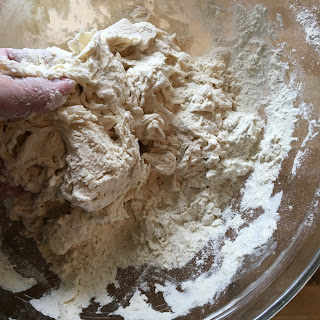As someone who bakes and cooks regularly, I'm mostly happy for these folks - because I think a lot of them will enjoy the kitchen.
At the same time, I have to admit that I'm a little worried for a few of them (I know some people who are just discovering their kitchens - and maybe would have been better without that discovery). And - honestly - I'm also a tad frustrated with how hard it's been to find those basics in the stores.
But I am happy that people are trying new things - and so I thought I should, too.
And, since we do happen to have some bread flour and yeast in the house and - since I wasn't going anywhere this weekend - I decided to try making a kneaded yeast bread for the first time.
(Spoiler alert... it went pretty well...)
Just a basic heads-up: The first video in this post comes in at just about 6 minutes long (the others are MUCH shorter). I cover a lot of ground in this one, though: what was going on when I last posted (January), what I've been doing since, who gave me the book I'm holding, and - oh, yeah - some stuff about why I'm baking the recipe I'm baking. I think it's worth it, but obviously it's up to you.
So... "Strange world" is probably a bit of an understatement these days, right? But spending some time in the kitchen can definitely be a great way to work on some relaxation. (Unfortunately, it's gotten a tad difficult for me to spend much time in my other favorite place - the grocery store.)
I looked through some cookbooks for a basic bread recipe, and kept finding things that had all sorts of exciting, exotic ingredients - which we don't have on hand. But I found a 4-ingredient bread recipe in Appetite by Nigel Slater:
|
|
| I admit that I did something with this recipe that I pretty much never do: I only did a half-size recipe. I figured it didn't make sense to do a full batch if we were going to end up with 2 loaves of bread we didn't want. |
So... four ingredients:
 |
| By the way - 1 packet of yeast is equal to 2 1/4 tsp of yeast. |
The next steps deal with mixing. And since I was about to get my hands dirty with the kneading, I figured I'd just go in hands-first:
 |
| Dry ingredients... |
Mixing that in, though, didn't give me the "sticky dough" that the recipe talked about:
I added a bit more water, little by little, ending up with about and extra half cup on top of the initial 1 1/2 cups - which gave me this sticky mass:
Flour on the board:
|
|
| I really like that Slater says that you don't need to beat up on it, and that if you end up exhausted you were doing it wrong. Honestly, I stared out the window and kneaded it for 10 minutes. It was kind of awesome. |
Since the recipe talks about the dough doubling in size, I did a quick measure before I put it into the bowl.
This went into a bowl with a towel over it and onto the top of the fridge - the warmest place in our kitchen.
I figured I didn't want to leave it in the first proofing stage for much longer, so I went ahead and flipped it out onto my floured board, kneaded it for about another 2 minutes, then plopped it onto my baking sheet.
So... We've listened and waited, and now - finally - we get to cut into it.
So, how was it?
And it was really pretty when I put it out, too:
Overall, it was pretty good. I'm not sure about the really thick crust - and whether that was on purpose, or something that I did.
I will say that Christopher and I both enjoyed it with our dinner, and I'm sure we'll enjoy the rest of the loaf over the next few days.
 |
| Here's the book that the recipe came out of. SUCH a great read! |
*****
So, what are you up to in the kitchen these days? Is there something you'd like me to attempt so you have some idea how it goes? Or just a question about what to do with the ingredients in your kitchen? Let me know and I'll see what I can help out with!




















